
Over the years of humanity looking to the heavens we have been aware of ‘stuff’ burning up in the atmosphere, in the early days we did not know what this was or where it came from, there are stories of “stones from the heavens” thrown by angry gods and in recent years archaeologists have found evidence that humanity has experienced some, if not impacts as we think of them, but airburst, akin to large nuclear explosions caused by these objects exploding as they entered denser and denser air layers.
Around 1650 BCE, the inhabitants of a Bronze Age city a few miles northeast of the Dead Sea were going about their daily chores, unaware of the doom headed nature had heading their way. The residents of what is now called Tell el-Hammam, which today is an important archaeological site in Jordan, would have noticed a small object enter the atmosphere at around 20km/s. It would have lit the sky up as if it was a second Sun, there is no way it would not have been noticed. As it ripped through the atmosphere, entering denser and denser layers, the mechanical and thermal stress increased dramatically, until at about 4500m above the ground it could take no more, the resultant explosion would have been several thousand times the yield of the nuclear blasts that destroyed Hiroshima or Nagasaki.
Any animals in the region at the time would have little chance of escape, perhaps some of the more quick witted, such as birds, would have reacted and tried to flee, but any left in the area, and especially any humans in the path of the explosion stood little chance of escape, oblivions dark cloak would cover them before they could react.
It would be over in a flash, Tell el-Hammam and the surrounding countryside would be transformed into an inferno. Anything made of combustible materials, such wood, clothing, trees, plants, grass etc would have burst into flames, while pottery, bricks, spears, and even metal objects, such as swords, pots and jewellery, would begin to melt as air temperatures likely spiked around 2000 degrees Celsius (3600 farenheight).
A few moments later, the shockwave would arrive. The air blast, whose velocity would have exceeded 1800km/hr, tore through the city and destroyed all in it’s path, like a giant hammer blow from above it sheared the top of a four-story palace, and blew the wreckage into the next valley . Archaeologist’s have estimated the city was home to at least 8000 people, and every animal or human perished, they were mangled, ripped apart, bones broken, and their bodies burnt. The shockwave continued on, and a minute later, slammed into biblical Jericho about fourteen miles west of Tell el-Hammam, and bringing down its historic walls. Scholars now believe that this ancient catastrophe, which we now have plenty of evidence for, likely gave rise to the biblical stories about the destruction of Sodom and Gomorrah.
We know this event happened around 3600 years ago, for over a decade, researchers sifted thought the remains of the city, finding a 1.5m thick layer of charcoal and ash dated to 1650BCE, buildings torn apart by some enormous cataclysm that cannot be explained by the geology of the region or the ability of mankind at that time.
The people in the region had no explanation for this event, no doubt that such a traumatic event would sit in the collective consciousness for generations, and without any way to explain the events of that day, it would have been deemed the actions of a demon or god – if the researchers are correct, then Christianity and Islam put the blame for this event squarely in the hands of God.
Based on the damage on the ground, the object in question was likely around 100m across and had a density of around 1500 to 1800 kg/m3, significantly larger than the object that blew up about 60km above Chelyabinsk in early 2013, resulting in over 1000 human injuries and an estimated 100,000 broken windows and several hundred damaged or collapsed walls. Neither of these objects left much of themselves behind, both vapourised as they detonated in the atmosphere and no fragments were large enough to form a crater.
So, how often does Earth get hit by these 100m sized objects? Well, estimates vary depending who you talk to, but crater formation rates from Mars, The Moon and other Solar system bodies indicate that over the past 4.4 billion years, Earth has likely been hit by a 100m sized object, on average, every 3100 years but as far as we know, no such object has hit Earth since the events in 1650BCE, however, Earth was once very sparsely populated by humans, with over 70% of covered by the global ocean, thus it is highly probable that any event of this nature that has taken place was likely not witnessed by any human, at least none who survived the experience.
Should we be worried, well this a rock and hard place scenario, such events must be kept in perspective, they are rare and thus they pose a much lower risk than many natural events humans are faced by every year, such as volcanic eruptions, Tsunami, floods etc, however, the problem is that when they do happen, they hold the potential to dwarf most natural disasters in their impact if they come down over a populated part of the plant. if a volcano starts to rumble and it starts to show signs of catastrophic collapse, in many, but not all, cases, we have enough warning to evacuate the area, but meteors do not give a warning to their presence, the smaller ones just appear in the sky and then follow the laws of the physics, meaning we have no time to react once it enters the atmosphere, where, depending on the angle it enters the atmosphere at, we may have anything from 5 to 40 seconds from first observation to detonation or impact.
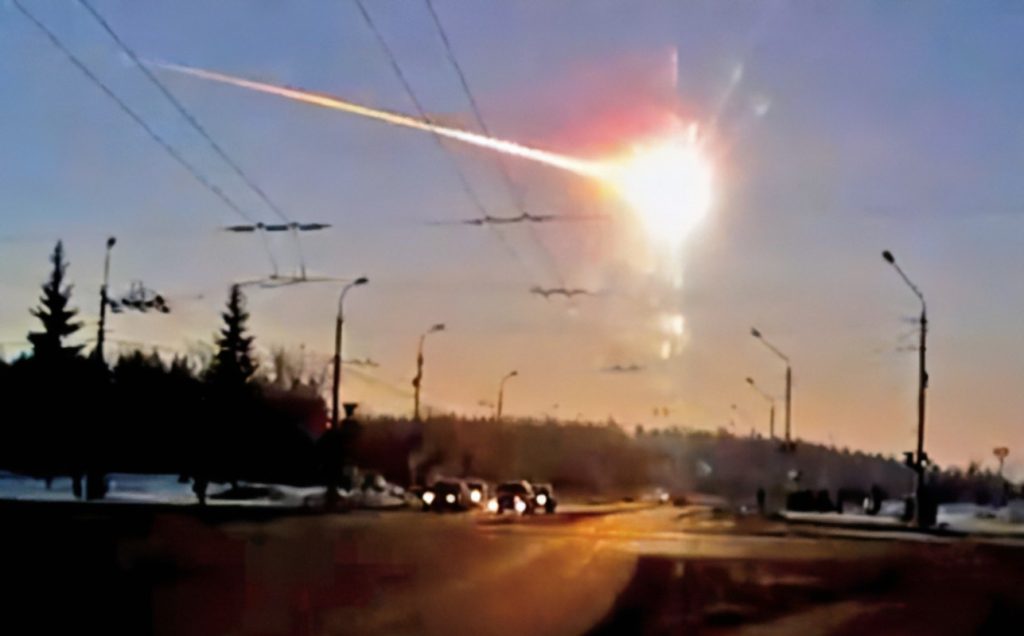
The object in the image above, as already noted, injured more than 1000 humans and caused $millions in damage to property, but this object was tiny, perhaps 17,000 tonnes and maybe 10m across, on average, enter our atmosphere around once a decade.
More common, perhaps weekly or at least monthly, we get objects like these below.
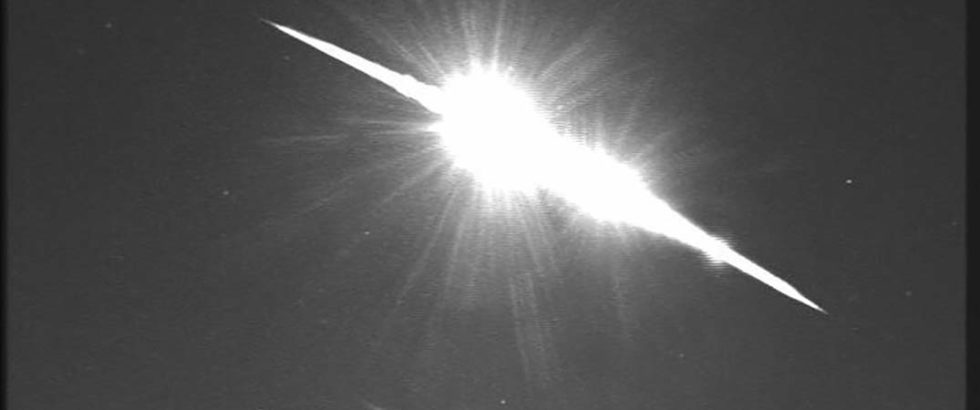
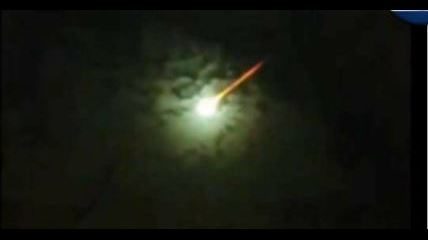
We have all seen the Hollywood films that feature asteroid impacts, in the 1970’s we had Meteor, then we had Armageddon, in which a group of oil workers saved humanity and then we had Deep Impact, in many ways, this last was the best depiction, but sadly all dealt with large objects, and the rarity of these events means we should not overly concern ourselves with these events.
Several decades ago the US Congress tasks NASA with locating and tracking all objects that are larger than 140m and have the potential to pose a threat to Earth, estimates of the true number of these objects vary, but NASA is confident it has found an estimated 90% of them – as as yet, none are on a collision course with our home – which is good news.
However, that still leaves 10% of these objects to be discovered, and given the vagaries of asteroid orbits, this picture can never be truly complete because some will be ejected out of the inner solar system, and others from outside will be drawn in to it, but most importantly, these objects likely will collide with other debris orbiting the Sun, and not only will this create a cloud of smaller debris, and some larger chunks, but it has the potential to alter orbits into an as yet unknown path, which could then become a hazard to Earth.
Finding and tracking asteroids is not as simple as it once was, all the larger objects and chunks have been found, most are tracked, but once we start looking at objects below 200 hundred meters across, it gets very tricky. These objects are darker than coal, their surface has been blasted with solar radiation for tens of millions to billions of years, and their size, coupled to their colour, makes them incredibly hard to locate, the best method is with infra-red, but there are no plans to build a telescope, which would need to be put into orbit, to look for these object at this time.
Lets have a scenario or two, what could we expect if objects of a given sized collided with Earth tomorrow?
Object 1: Effects at a distance of 10km from the impact site.
- Size: 130m
- Density/type: 6800kg/m3 – Nickel-Iron
- Entry velocity: 32km/s
- Impact Angle relative to the ground: 90 degrees
- Impact ground density/type: 2750kg/m3 – Crystalline rock
- Before atmospheric entry: 4.01x10E18 Joules (957 Megatons of TNT)
- Averaged time between these impacts: 260,000 years
Atmospheric Entry:
- The projectile will start to break up about 32,600m above the surface and will reach the ground in a broken condition.
- The surviving large pieces of the object hit the ground at around 30.5km/s
- The energy lost into the atmosphere: 2.65x10E17 Joules (6.32 Megatons)
- Impact energy of largest fragment (80% of original mass): 3.74x10E18 Joules (894 Megatons) – 44,700 times the power of the Nuclear weapon dropped on Hiroshima.
Crater:
- Type: Complex
- Transient Crater diameter: 4km+/-250m
- Transient crater depth: 1.5km +/-250m
- Final Crater diameter: 4.8km +/-250m
- Final crater depth: 500m +/-100m
Thermal effects of Impact:
- Time from Impact to maximum irradiation: ~100 milliseconds
- Visible fireball radius: 3.2-3.5km
- The fireball would appear around 70 times the size of the Sun
- Thermal exposure: 1.78x10E7 Joules/m2
- Duration of irradiation: ~ 41seconds
- Radiant flux compared to the Sun: 441 times the solar irradiance
About 2 seconds after the impact, where you are stood would be subject to a magnitude 6.5-7.0 Earth quake.
Air Blast:
- The air blast would arrive at your site around 30.5 seconds after the impact
- Peak over pressure at your location: 650KPa or 6.5Bar (92.2Psi) (Normal atmospheric pressure is 1.0 Bar, so this is 6.5 times that. Overpressures above 28Kpa can be fatal, over 69Kpa it can blow limbs off. )
- Maximum air mass velocity at your location: 597m/s (2,150km/hr) – the maximum sustained winds for a Pacific Hurricane are calculated at 322km/hr, so this is a wind speed more than 6.5 times the speed of the most powerful Hurricanes on Earth and around 5 times the most powerful Tornado winds.
- Sound Intensity of the blast front: ~116dB – enough to damage and hurt hearing, assuming you survive the blast, which is unlikely.
From the above effects of such an impact we can see that even 10km away from the event, the results will almost certainly be fatal for exposed humans. Your clothes would flash ignite, you would suffer 3rd degree burns over most of your body, and if you survived that, the air blast that followed would certainly kill you with the overpressure – and if, by some miracle, you survived that, then debris raining down from the sky that was ejected when the crater formed, would likely kill you, either through suffocation – as volcanic ash can do, or because large enough fragments of rock and melt fell down and killed you on impact.
Even if we reduce the properties of the object from that above, it would still be a very bad day for anyone living nearby.
Object 2: Effects at a distance of 10km from Impact site
- Size: 80m
- Density/type: 2600kg/m3 – Silicate rock
- Entry velocity: 30km/s
- Impact Angle relative to the ground: 40 degrees
- Impact ground density/type: 2500kg/m3 – Sedimentary rock
- Before atmospheric entry: 2.18 x 1017 Joules (5200 Megatons TNT)
- Averaged time between these impacts: 2,800 years
Atmospheric Entry:
- The projectile will start to break up about 64,600m above the surface
- The projectile will explode into a swarm of fragment about 3200m above the surface
- The energy of the airburst is 2.07 x 1017 Joules = 494 Megatons. (More than 22,000 times the force of the Nuclear weapon dropped on Hiroshima)
- No crater is formed, although large fragments may strike the surface.
- The largest fragments will strike the ground with a velocity of around 6km/s
Thermal effects of Impact:
- Time from Impact to maximum irradiation: ~100 milliseconds
- Visible fireball radius: 1.2-2.5km
- The fireball would appear around 50 times the size of the Sun
- Thermal exposure: 1.31x10E7 Joules/m2
- Duration of irradiation: ~ 25seconds
- Radiant flux compared to the Sun: 320 times the solar irradiance
Air Blast:
- The air blast would arrive at your site around 31 seconds after the impact
- Peak over pressure at your location: 121KPa or 1.21Bar (17.2Psi) (Normal atmospheric pressure is 1.0 Bar, so this is 1.21 times that. Overpressures above 28Kpa can be fatal, over 69Kpa it can blow limbs off. )
- Maximum air mass velocity at your location: 200m/s (720km/hr) – the maximum sustained winds for a Pacific Hurricane are calculated at 322km/hr, so this is a wind speed more than 2.2 times the speed of the most powerful Hurricanes on Earth and around 1.5 times the most powerful Tornado winds.
- Sound Intensity of the blast front: ~102dB – enough to damage and hurt hearing.
Although the thermal impact of this event would be dramatically less than the first and the danger of spontaneous fires are minimal, many buildings would suffer structural damage or collapse at 10km from such an event, this alone could trigger secondary fires. Windows would be blown out to about 16km from the detonation site, trees would be blown down or stripped of branches and leaves. Animals would likely be killed if exposed to the shock front and any birds would be unlikely to survive.
According to experts, such events occur, on average over the history of Earth, every 2,800 years, as far as we know, no such event has happened in the last few thousand years. Many commentators may ask about Tunguska, but that event, whilst powerful, was distinctly less powerful from a far smaller object, likely between 15m and 25m is size.
When we start to consider if there is a hazard to humanity from air burst or small impact events we not only have to take into account the volume of such objects entering the atmosphere, but we need to take into account the amount of the Earth’s surface occupied by humanity, and that is surprisingly less than many people would instinctively think.
Here is some information about the surface of Earth.
Area of the surface covered by the Global Ocean: 71%
Area of the surface covered by dry land: 29%
So you can see that around 2/3rds of all objects are likely to burst or impact in the global ocean, with the Pacific being the largest ocean basin and likely accounting for about 40% of all oceanic strikes.
However, the dry land is not fully occupied by humanity.
| Antarctica: | 8.30% | ||||
| Greenland: | 1.20% | ||||
| Glaciers/Ice: | 0.50% | ||||
| Lakes: | 0.65% | ||||
| Deserts (excluding Antarctica and Greenland: | 28% | ||||
| Mountain Terrain (Uninhabitable): | 3.27% | ||||
| Total land not occupiable by humans: | 41.92% | ||||
So this means that 41.92% of the surface of Earth that is potentially available to humans to use, is actually not usable by us, however, this picture is also not accurate, there are many areas of mangrove, swamp, and semi-frozen tundra that is not included here, when calculated together, this removes another, approximately, 21% of the dry land mass.
Thus, when this is added up, around 60% of the dry land surface of the planet is not available to us.
Further, the SEDAC (SocioEconomic Data and Applications Centre), run by Columbia University with funding from NASA, estimated in their Gridded Population of the World and Global Rural-Urban Mapping Project (GRUMP) in their latest GPWv4 estimated that humanity occupies no more than some 2.7% of the available dry land.
As you can see, even if such events happen more commonly that we believe, then the odds of them being seen by a human are reduced dramatically, especially when you take into account that this is an estimate of the current human occupation – our technology overcomes many of these restrictions, with satellites capable of monitoring the entire atmosphere continually, but before the 1960’s this was not possible, human population and surface exploitation was significantly lower than today, thus, it is likely that events of the type described above may have taken place numerous times in the last few thousand years, they were just not seen by any human that survived the experience, or it may have been observed by a population that had no written language and thus we have no record of it.
What we can conclude it that whilst these events happen on a fairly regular basis, the inherent danger to humanity is quite low. Of course there is always the small chance that such an event could, and one day will, happen over a populated region with all the commensurate effects that would have, but in reality, the chance of something like this happening over a major city in any given year is around 1/22,000, and the odds of a person being killed by such an event is significantly lower than this, you are probably more likely to win the jackpot in a national lottery two weeks in a row than be killed by an air burst or impact event.

However, many people are fascinated not with these small vents, but with extinction level events, however, even here the picture gets murky. We all have read or heard about the K-T event, the impact, 66 million years ago, that is said to have killed the dinosaurs, ending their 150 million year reign on the planet.
The reality is, that whilst this is a compelling story, we know the event actually happened, the buried crater is located in what is modern day Mexico, on the coast of the Yucatan peninsula, centred on the town of Chicxalub, from where it gets it’s common name, and we know that no dinosaur fossils have been discovered above this layer, we also know that it killed around 73% of life on Earth at the time, it is likely the dinosaurs were in decline anyway and would eventually have gone extinct regardless of the impact. However, whilst the 240km wide Chicxalub crater is the largest formed for several hundred million years on Earth, it was not the only large impact crater and in fact, in the previous 10 million years, there were a number of impacts that formed craters in excess of 20km across, all of which would have had a devastating impact on the environment and atmosphere of the planet.
Here is a list of confirmed, or often agreed upon, impact craters that have been identified on Earth. In many cases there ages are fairly well known through normal aging techniques or other methods, however, some are not clear and may have a huge range in possible ages. If you look at the conformed craters in the lower section and look at them in 25 million years sections, it appears that crater rates are increasing, but this is caused by observational bias, the reality is that the crater rate has been reasonably steady for around 1.5 billion years, it is that geological and chemical processes on our ever active planet have damaged or destroyed older craters, further, many are likely on the ocean floor and have yet to be discovered as our mapping data for the ocean depths is incomplete and not at the accuracy needed to identify all but the very largest of craters – where they are clearly defined.
Table 1: Confirmed or accepted impact Craters
| Name | Location | Country | Diameter | Age |
| (km) | Thousand years | |||
| Wabar | Rub’ al Khali desert | Saudi Arabia | 0.1 | 0.2 |
| Kaali | Saaremaa | Estonia | 0.1 | 4 |
| Campo del Cielo | Chaco | Argentina | 4 | |
| Henbury | Northern Territory | Australia | 0.2 | 4.2 |
| Morasko | Poznań | Poland | 0.1 | |
| Boxhole | Northern Territory | Australia | 0.2 | 5.4 |
| Macha | Sakha Republic | Russia | 0.3 | 7.3 |
| Rio Cuarto (disputed) | Córdoba Province | Argentina | 4.5 | 10? |
| Ilumetsa | Põlva County | Estonia | 0.08 | 6.6 |
| Whitecourt | Alberta | Canada | 0.04 | 1.1 |
| Wolfe Creek | Western Australia | Australia | 0.9 | < 120 |
| Monturaqui | Atacama Desert | Chile | 0.455 | 640 ± 140 |
| Tenoumer | Sahara Desert | Mauritania | 1.9 | 21 |
| Yilan | Heilongjiang | China | 1.85 | 49 |
| Meteor Crater | Arizona | United States | 1.2 | 49 |
| Xiuyan | Xiuyan | China | 1.8 | 50 |
| Lonar | Maharashtra | India | 1.8 | 52 |
| Agoudal | Atlas Mountains | Morocco | 3 | 105 |
| Tswaing | Pretoria Saltpan | South Africa | 1.1 | 220 |
| Zhamanshin | Kazakhstan | Kazakhstan | 14 | 900 ± 100 |
| Name | Location | Country | Diameter | Age |
| (km) | Million years | |||
| Bosumtwi | Ashanti | Ghana | 10 | 1.1 |
| Elgygytgyn | Chukotka Autonomous Okrug | Russia | 18 | 3.5 |
| Bigach | Kazakhstan | Kazakhstan | 8 | 5 |
| Karla | Tatarstan | Russia | 10 | 5 |
| Karakul | Pamir Mountains | Tajikistan | 52 | 5? 25? |
| Nördlinger Ries | Bavaria, Baden-Württemberg | Germany | 24 | 14.808 ± 0.038 |
| Chesapeake Bay | Virginia | United States | 40 | 34.86 ± 0.23 |
| Popigai | Siberia | Russia | 100 | 35.7±0.2 |
| Mistastin | Newfoundland and Labrador | Canada | 28 | 36.4 |
| Haughton | Nunavut | Canada | 23 | 39 |
| Logancha | Siberia | Russia | 20 | 40 |
| Kamensk | Southern Federal District | Russia | 25 | 49 |
| Montagnais | Nova Scotia | Canada | 45 | 50.5 |
| Chicxulub | Yucatán | Mexico | 150 | 66.051 ± 0.031 |
| Nadir Crater | Guinea Plateau | Guinea | 8.5 | 66.051 ± 0.031 |
| Boltysh | Kirovohrad Oblast | Ukraine | 24 | 65.17 |
| Kara | Nenetsia | Russia | 65 | 70.3 |
| Manson | Iowa | United States | 35 | 74 |
| Lappajärvi | Western Finland | Finland | 23 | 77.85 ± 0.78 |
| Steen River | Alberta | Canada | 25 | 91 |
| Tookoonooka | Queensland | Australia | 55 | 112–133 |
| Carswell | Saskatchewan | Canada | 39 | 115 |
| Tunnunik | Northwest Territories | Canada | 25 | 130–450 |
| Mjølnir | Barents Sea | Norway | 40 | 142 |
| Gosses Bluff | Northern Territory | Australia | 22 | 142.5 |
| Morokweng | Kalahari Desert | South Africa | 70 | 146.06 ± 0.16 |
| Puchezh-Katunki | Nizhny Novgorod Oblast | Russia | 40 | 195.9 ± 1.0 |
| Obolon’ | Poltava Oblast | Ukraine | 20 | 169 |
| Rochechouart | France | France | 23 | 206.92 ± 0.32 |
| Manicouagan | Quebec | Canada | 100 | 215.56 ± 0.05 |
| Saint Martin | Manitoba | Canada | 40 | 227.8 ± 1.1 |
| Araguainha | Central Brazil | Brazil | 40 | 244.4 |
| Clearwater West | Quebec | Canada | 36 | 290 |
| Clearwater East | Quebec | Canada | 26 | 290 |
| Charlevoix | Quebec | Canada | 54 | 342 |
| Woodleigh | Western Australia | Australia | 40 | 364 |
| Siljan Ring | Dalarna | Sweden | 52 | 377 |
| Slate Islands | Ontario | Canada | 30 | 450 |
| Presqu’île | Quebec | Canada | 24 | less than 500 |
| Acraman | South Australia | Australia | 90 | 580 |
| Beaverhead | Idaho and Montana | United States | 60 | 600 |
| Amelia Creek | Northern Territory | Australia | 20 | 600–1660 |
| Strangways | Northern Territory | Australia | 25 | 646 |
| Keurusselkä | Western Finland | Finland | 30 | 1400–1500 |
| Shoemaker | Western Australia | Australia | 30 | 1630? |
| Dhala | Madhya Pradesh | India | 11 | 1700-2100 |
| Sudbury | Ontario | Canada | 130 | 1849 |
| Vredefort | Free State | South Africa | 160 | 2023 |
| Yarrabubba | Western Australia | Australia | 30 | 2229 |
What is interesting when you look at this list of impact craters, only only 5 are 100km across or larger, see below.
Table 2: Craters over 100km
| Name | Location | Country | Diameter | Age |
| (km) | Million years | |||
| Vredefort | Free State | South Africa | 160 | 2023 |
| Chicxulub | Yucatán | Mexico | 150 | 66.051 ± 0.031 |
| Sudbury | Ontario | Canada | 130 | 1849 |
| Popigai | Siberia | Russia | 100 | 35.7±0.2 |
| Manicouagan | Quebec | Canada | 100 | 215.56 ± 0.05 |
What is interesting is the age spread of these craters, from 35.7 million years to 2023 million years, implying an average impact timescale for this size of impact of around 400 million years – but is this correct, we can see that three of the 5 100km+ craters were formed within the last 215 million years, and with the last one being 35.7 million years ago implies a frequency of around 59 million years. Objects large enough to create 100km wide craters are not uncommon across the solar system as a whole, depending on the material it is made from, the object can be anything from 14-18km across and the impact force will also depend on the velocity it collides with Earth.
Within the inner solar system we have several classes of asteroids which have several members significantly larger than 20km, however, at this time none are in orbits that bring them close the Earth, of those that form the objects commonly referred to as NEAs or Near Earth Asteroids, there are few that are larger than around 8km, with most being less than 1km, but there are more in the inner solar system than you may realise.
As of August 2022, there are more than 19,300 NEAs known and have orbital plots, those which approach Earth are called Potentially Hazardous Asteroids (PHAs), the image below plots them against the inner solar system.
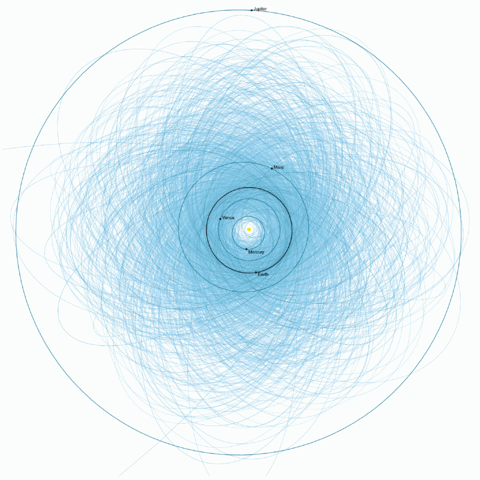
One of the smallest NEAs is 2008 TS26, it is believed to have a diameter of around 1m, however, the largest NEA is 1036 Ganymed, with diameter estimated at 41 km.
One of the larger NEAs, 3122 Florence, has an estimated diameter of 4.5 k, and has two moons of between 100m – 300m across.
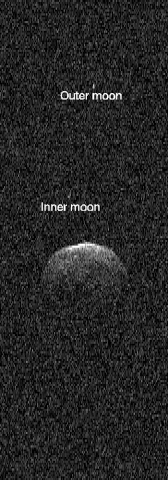
Predicting the exact number and accurate sizes of NEAs has been a controversial topic for a long time. The latest reports from 2019 suggest that over 1,000 such objects have diameters of above 1 km, and more than 8,500 NEAs are larger than 140 m in diameter.
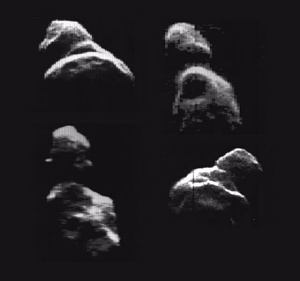
The above radar images of Toutatis reveals something interesting, a history of impacts, given that NEAs are short lived objects, they either impact one of the inner solar system planets, the Sun or are ejected into longer orbits, it is estimated that most are only NEAs for perhaps a few million years, we must conclude that whilst they are NEAs they undergo frequent collisions with other material in the inner solar system. There is a belief that asteroids with moons have them following impacts, material is ejected as a result of a low velocity collision and rather than escaping, some is captured into orbit where it remains until perturbed by the gravity of another body or is impacted and either ejected from the system, destroyed or knocked into an orbit that will result in a collision with the parent asteroid.
This brings us to an interesting point. The tracking of Near Earth Asteroids and Potentially Hazardous Asteroids is well established, and we can accept they have it as accurate as both current knowledge and technology allows, the story of 99942 Apophis is evidence of this.
Following it’s discovery in 2004, it was originally thought the asteroid could impact Earth on Friday 13th 2029, but if not then on it’s next close approach in 2036, however, further observations and study has cleaned up the orbital data and showed that, whilst it will be a close approach in 2029, there is no risk of an impact within the next 100 years, beyond that is difficult to calculate due to perturbations in the orbit of the asteroid around the Sun. Apophis is more than 300m across, it is rare for an Asteroid of this size to approach Earth as close as it will in 2029, estimated at 31,700km above the surface, it will likely be visible to observers on the ground, although here in the UK the clouds will undoubtedly block any potential sighting.
However, given that Toutatis, and other studied asteroids in the inner solar system, suggest a regular and complex collision history, perhaps we should also be plotting their orbits in relation to each other in case a collision between to harmless objects diverts one into a path that will bring it to a collision with Earth that is currently unpredicted.
The largest objects in the inner solar system, in excess of 10km, are likely OK, it would need to be a substantial collision to so drastically alter their orbits to the point where they pose an imminent threat of collision with Earth, but objects below 1km are likely easily perturbed by collisions with the much more numerous boulder sized rocks we have yet to discover, it is a small chance, but objects we currently consider safe may be involved in a collision that puts them on a collision course with Earth sooner than anyone thought.
Perspective is key to this, no matter the true volume of rocks etc in the inner solar system the inherent risk of impact remains tiny and so whilst we must not be ignorant of the danger or become complacent, we must not overtly worry either, just like dormant volcanoes, we will get surprised one day, but the risk from volcanic activity or massive earthquakes far exceeds the risk from falling rocks.
Can we prevent Impacts with Earth?
The proverbial $64,000 question…in short, the answer would appear to be YES if we have sufficient warning and cooperation to do so. On Monday 26th September 2022 at 19:14hrs Eastern Daylight Time, the NASA spacecraft DART (Double Asteroid Redirection Test) will impact the small moon, Dimorphous, of the asteroid 65853 Didymus, this is a proof of concept mission to determine if kinetic impactors are capable or deflecting an asteroid.
Over the years there have been various proposals for planetary defence systems, from nuclear weapons, space tugs to kinetic impactors like DART, it is hoped that DART will give us the information we require to ensure that should an object be detected and we have sufficient time, we would be able to launch a simple and effective kinetic energy spacecraft to intercept the object, modify the orbit slightly, so that the Earth and it are no longer on a collision course.
Here is a link to the Media Briefing for the impact by DART
References:
All calculations for the effects of impacts are based on formula created by Robert Marcus, H. Jay. Melosh and Gareth Collins.
This article will be updated with further information as it becomes available and as I have time to add it.